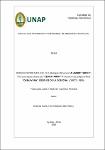| dc.contributor.advisor | Alván Ruíz, Jorge Elías | |
| dc.contributor.author | Rodríguez Reátegui, Evelin Paola | |
| dc.date.accessioned | 2017-03-16T16:45:04Z | |
| dc.date.available | 2017-03-16T16:45:04Z | |
| dc.date.issued | 2015 | |
| dc.identifier.uri | http://repositorio.unapiquitos.edu.pe/handle/20.500.12737/4313 | |
| dc.description.abstract | El trabajo de investigación se realizó en dos bosques naturales de terraza alta (Jenaro Herrera e Iquitos – Nauta km 49 – 70). El objetivo fue realizar cosecha comercial, aplicando técnicas de manejo sostenible, para las especies de Thoracocarpus bissectus “cesto tamshi”, Heteropsis flexuosa “alambre tamshi” y Desmoncus polyacanthos “cashavara”. Para las dos primeras especies se utilizaron 6 tratamientos y 8 repeticiones; para Desmoncus polyacanthos fueron 4 tratamientos y 8 repeticiones. Los mejores resultados se obtuvieron en Jenaro Herrera, para Thoracocarpus bissectus en el tratamiento t2 (dejando una raíz inalterada y sin embolsar) el incremento de fibra mensual fue 341,88 cm; en Heteropsis flexuosael mejor tratamiento fue t5 (dejando tres raíces inalteradas y embolsado) con 419,67 cm de fibra mensual y, en Desmoncus polyacanthos la mejor producción de fibra fue en el tratamiento t3 (manejo al 25% de tallos remanentes) con promedio de 883,66 cm. Los individuos de Thoracocarpus bissectus y Heteropsis flexuosa presentaron mejor vigor en J. Herrera. | es_PE |
| dc.description.abstract | The investigation work was carried out in two natural forests of high terrace (Jenaro Herrera and Iquitos - Nauta km 49 - 70). The objective was to carry out commercial crop, applying technical of sustainable handling, for the species of Thoracocarpus bissectus "handbag tamshi", Heteropsis flexuosa "wire tamshi" and Desmoncus polyacanthos "cashavara". For the first two species 6 treatments and 8 repetitions were used; for Desmoncus polyacanthos they were 4 treatments and 8 repetitions. The best results were obtained in Jenaro Herrera, for Thoracocarpus bissectus in the treatment t2 (leaving an unaffected root and without pocketing) the increment of monthly fiber was 341,88 cm; in Heteropsis flexuosael better treatment it was t5 (leaving unaffected and pocketed three roots) with 419,67 cm of monthly fiber and, in Desmoncus polyacanthos the best fiber production was in the treatment t3 (I manage to 25% of shafts remainders) with average of 883,66 cm. The individuals of Thoracocarpus bissectus and Heteropsis flexuosa presented better vigor in J. Herrera. | en_US |
| dc.description.uri | Tesis | es_PE |
| dc.format | application/pdf | es_PE |
| dc.language.iso | spa | es_PE |
| dc.publisher | Universidad Nacional de la Amazonía Peruana | es_PE |
| dc.rights | info:eu-repo/semantics/openAccess | es_PE |
| dc.rights | Attribution-NonCommercial-NoDerivs 3.0 United States | * |
| dc.rights.uri | http://creativecommons.org/licenses/by-nc-nd/3.0/us/ | * |
| dc.source | Universidad Nacional de la Amazonía Peruana | es_PE |
| dc.source | Repositorio Institucional - UNAP | es_PE |
| dc.subject | Regeneración natural | es_PE |
| dc.subject | Alambre tamshi | es_PE |
| dc.subject | Heteropsis flexuosa | es_PE |
| dc.subject | Cesto tamshi | es_PE |
| dc.subject | Thoracocarpus bissectus | es_PE |
| dc.subject | Cashavara | es_PE |
| dc.subject | Desmoncus polyacanthos | es_PE |
| dc.title | Regeneración natural de Heteropsis flexuosa "alambre tamshi". Thoracocarpus bissectus "cesto tamshi" y Desmoncus polyacanthos "cashavara", después de la cosecha, Loreto, Perú. | es_PE |
| dc.type | info:eu-repo/semantics/bachelorThesis | es_PE |
| thesis.degree.discipline | Ingeniería Forestal | es_PE |
| thesis.degree.grantor | Universidad Nacional de la Amazonía Peruana. Facultad de Ciencias Forestales | es_PE |
| thesis.degree.level | Título Profesional | es_PE |
| thesis.degree.name | Ingeniero Forestal | es_PE |
| thesis.degree.program | Regular | es_PE |


